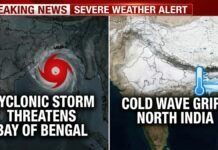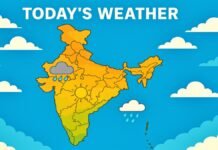
Key Points
- Heatwave Alert: India is expected to experience an unusually hot summer from April to June, with heatwave days doubling in several regions.
- Affected Areas: Central, eastern, and northwestern plains, including states like Uttar Pradesh, Bihar, Odisha, and Rajasthan, will face the brunt.
- Temperature Spike: Both day and night temperatures are predicted to remain above normal across most parts of the country.
- Global Warming Impact: Climate change and reduced western disturbances are driving the rise in extreme heat events.
New Delhi: The India Meteorological Department (IMD) has issued a stark warning for the summer of 2025, predicting record-breaking heat across the country. From April to June, India is likely to witness a significant increase in heatwave days doubling in many regions compared to previous years. This comes after an unusually warm start to the year, with March temperatures recorded at 0.78°C above the long-period average (LPA).
IMD Director General Dr. Mrutyunjay Mohapatra attributed the rising temperatures to insufficient western disturbances and the broader impact of global warming. “The frequency, intensity, and duration of heatwaves are increasing due to climate change,” he said.
Regions Under Threat
The IMD has identified central, eastern, and northwestern plains as the most vulnerable regions this summer. States expected to face severe heatwaves include:
- Northern Plains: Uttar Pradesh, Bihar, Haryana, Punjab
- Central India: Madhya Pradesh, Chhattisgarh
- Eastern States: Odisha, Jharkhand, West Bengal
- Western Regions: Rajasthan, Gujarat
- Other Affected Areas: Maharashtra (Vidarbha), Telangana, Andhra Pradesh
In these areas, heatwave days could rise from the usual 4–7 days to as many as 10–11 days by June.
What is a Heatwave?
The IMD declares a heatwave when temperatures in plains exceed 40°C and are at least 4.5°C–6.5°C above normal. A severe heatwave is declared when this deviation exceeds 6.5°C.
Why is This Summer Different?
Several factors are contributing to this year’s extreme heat:
- Global Warming: Rising greenhouse gas emissions have intensified climate change impacts across India.
- Reduced Western Disturbances: Cooler weather systems that typically moderate temperatures during winter were weaker this year.
- Urbanization: Rapid urban growth has increased heat retention in cities like Delhi and Mumbai.
Impact on Daily Life
The soaring temperatures could have widespread consequences:
Health Risks
- Increased cases of heatstroke, dehydration, and other heat-related illnesses are expected. Vulnerable groups such as children, the elderly, and outdoor workers are at higher risk.
Agriculture
- Late-sown wheat crops in northern states may face moisture stress due to rising temperatures.
- Prolonged heat could reduce yields of perishable crops like fruits and vegetables.
Energy Demand
- Peak electricity demand is projected to rise by 9–10% as air conditioner usage surges.
- Strain on power grids could lead to outages in some regions.
Water Scarcity
- Higher temperatures will increase water demand for irrigation and drinking purposes, potentially leading to shortages in drought-prone areas.
What Lies Ahead?
While April’s rainfall is expected to be normal in many regions, it may not be enough to offset the impact of rising temperatures. The IMD has ruled out El Niño conditions this summer a relief since El Niño typically exacerbates heatwaves and reduces monsoon rainfall.
However, experts warn that India must prepare for more frequent extreme weather events in the coming years due to climate change.
How Can You Stay Safe?
To mitigate the impact of extreme heat:
- Stay hydrated and avoid direct sun exposure during peak hours (12 PM–4 PM).
- Wear light-colored clothing and use sunscreen when outdoors.
- Ensure proper ventilation or cooling systems indoors.
- Keep an eye on weather updates from reliable sources like IMD.
The summer of 2025 is shaping up to be one of the hottest on record for India, with significant increases in both day and night temperatures across most regions. As climate change drives more frequent and intense heatwaves, proactive measures both at individual and policy levels are crucial to safeguard public health and livelihoods.



















































